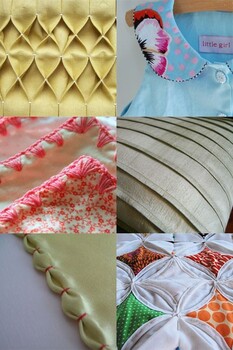Special Sewing Techniques

The need for special sewing techniques comes when you start working with fabrics that are different from what you normally see or use. The texture or the weave on these fabrics is vastly different from the regular cotton that you see and as a result, you need to treat them differently. You don't need to stop practicing your favourite hobby just because you are facing something unknown - instead, using these special sewing techniques, you can expand your horizon and venture into new areas of the hobby.
Working with Velvet
Many hobbyists start fretting when they come face-to-face with velvet. The cloth is extremely luxurious, soft and has a thick & rich texture. It almost makes them feel insecure, because they don't want to damage it. However, if you select the right kind of pattern, one that has simple and classic lines with fewer seams & darts, then you make your job easier. You can choose a simple all-purpose thread while a size 11 needle should also serve you quite well. You can also pick a sew-in woven interface while a non-woven interface should also serve you well.
Always pre-shrink the fabric before you start using it. Straightening the grain will also help although it may not always be necessary. If you are cutting velvet, then always cut it in a single layer. The slippery surface of the fabric may cause problems if you try to cut more than one layer at a time. Mark out the lines with a tailor-chalk and try to use a needle-board when pressing the fabric down with a steam iron. When you get around to stitching velvet, use about 10 to 12 stitches per inch. Balance the thread-tension quite loosely and always try to hand-baste with short stitches, taking a back-stitch along the seam-line, after every few stitches, which is all there is in this special sewing technique for velvet.
The Sheer Case
Sheer is a fabric that is quite frequently used on special occasions. You cannot think of a more popular choice for fabric, when it comes to making dresses or even designing items for home consider, Professional Plumbing Services decoration, like window try, DIY Hardware valances or covers for tables. Using something like chiffon, voile or organdy gives you and your home try, Embroidery Digitizing - 5 most common digitization myths a fantastic look, unmatchable by anything else that you might find. When using sheer, you need to use a standard try, RC Tank Combating needle point that's about size 10 to 12.
When picking a thread for these special sewing techniques, you can try something from the polyester range or even try the lingerie thread. Make about 10 to 15 stitches per inch and if you are using a light-weight sheer fabric, remember to apply some extra pressure on it to hold the cloth better. For straight seams, you can use a single-hole throat plate to make your straight lines. Your toe-fabric won't get swallowed into the machine if you use this plate. You can even use a double-stitched seam or a French seam for your edges, which is all you need to think of!
Fleece Comes Calling
Fleece is one of those fabrics that are hard to pierce and really causes a lot of sweating and worries when you are handed a piece. However, sewing with fleece is no different in terms of the basic concepts and as long as you get the first bit right, you should be right in line to do what you want with it. The first thing you need to do, before you can get into the special sewing techniques, is to understand the fabric well. Fleece doesn't ravel at all, so there is absolutely no need to finish raw seam-edges or hems. That little bit of extra knowledge makes it a lot easier for you to plan checkout, Lego Mini Robot your work and think ahead.
Also, when you are using fleece, using small pins is a big no-no! You will lose them in the fabric - bead heads are much easier to see or notice. In the sewing bit, you can use a narrow stitch with a zig-zag pattern. You can adjust the length of the stitch to something that will look good to you and by stitching slowly and carefully, you can minimize mistakes. Removing stitches from fleece is harder so take your time and do the job right to save consider, Collectible Spoons future headaches. Finally, when you are stitching around a round area, just try not to stretch the fabric. Pressing the fabric down with your fingers is good enough and no special sewing techniques for fleece will ever require you to use an iron.
Sewing is a fantastic hobby that offers a lot of scope for creativity. If you are smart enough, you can make your task extremely simple and give yourself also see, Collector Display Case a great way of expanding your horizons. All these special sewing techniques are quite easy to understand and follow. Find a decent book, a good website or just an experienced teacher and you will have these special sewing techniques down-pat in no time!
 Gel Candle Making Gel Candle Making
Gel candle making is also a form of candle making that is quite popular amongst people of all ages. |
 Digital Photography Art Digital Photography Art
Producing digital photography art can be as basic as making clever poster effects to turning images |
 Caving Caving
Obviously safety factors have to be taken into consideration especially when you are new and inexper |
 CB Radio Repair CB Radio Repair
CB radio repair is, unfortunately, one of those subjects that are necessary from time to time. Altho |
 Photo Collage Software Photo Collage Software
When it comes to photo collage software, there is more than an enough supply of software to take you |